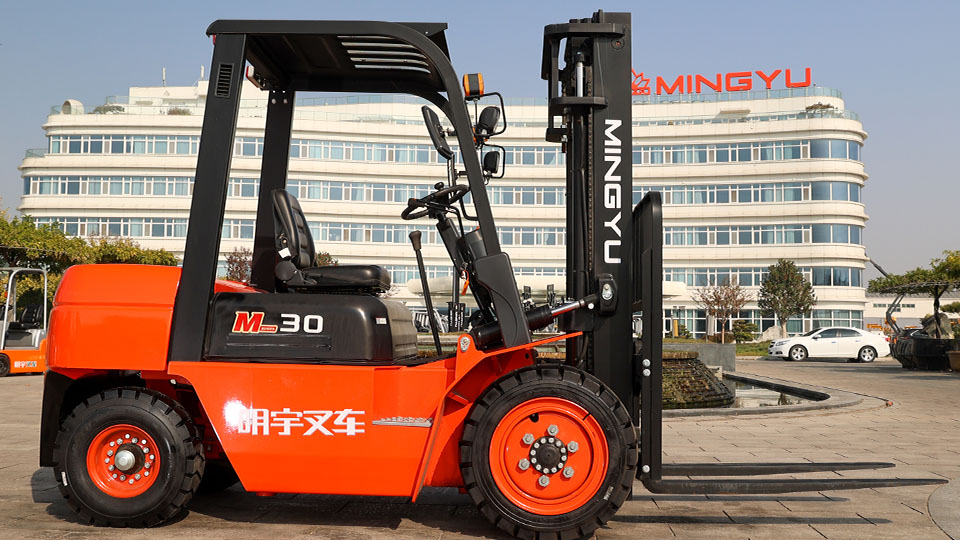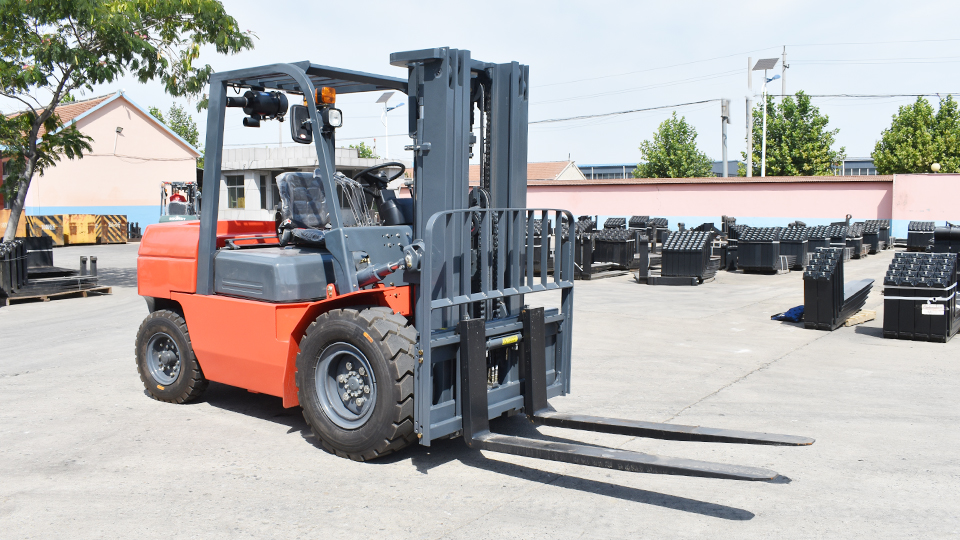
I. Common Forklift Propane Tank Sizes and SpecificationsThe industrial LP tank market is dominated by two primary sizes, though the smaller of the two accounts for the vast majority of forklift applications.21. The Standard Cylinder: 33.5 lb Capacity3This is the most widely used tank size for standard counterbalance, pneumatic, and cushion-tire forklifts in warehouse and manufacturing environments.4 Its size offers an excellent balance between operational run-time and manageable weight for manual changing by an operator.SpecificationMetric EquivalentValueNominal Propane Capacity$15.2$ kg$33.5$ lbsLiquid Volume Capacity$29.9$ Liters$7.9$ GallonsTypical Diameter$31.8$ cm$12.5$ inchesTypical Height$67.9$ cm$26.75$ to $29$ inchesEmpty Weight (Tare Weight)$10.0 - 15.9$ kg$22$ to $35$ lbs (Aluminum vs. Steel)Full Weight$25.2 - 31.1$ kg$55$ to $68.5$ lbsTypical Run Time$6$ to $8$ hours (a full shift)The 5$33.5$ lb tank is designed to provide enough fuel for an average single work shift (around 8 hours) for most Class IV and Class V internal combustion forklifts.62. The Heavy-Duty Cylinder: 43.5 lb Capacity7A larger tank is sometimes necessary for high-volume operations or for forklifts with very large engines designed for heavy-duty lifting, rough terrain, or long travel distances.SpecificationMetric EquivalentValueNominal Propane Capacity$19.7$ kg$43.5$ lbsLiquid Volume Capacity$\approx 37.8$ Liters$\approx 10$ GallonsTypical Diameter$31.8$ cm$12.5$ inchesTypical Height$86.4$ cm$34$ inchesFull Weight$\approx 34$ kg$\approx 75$ lbsTypical Run Time$5$ to $6$ hoursWhile offering greater capacity, the $43.5$ lb tank's significantly heavier full weight ($75$ lbs) makes it more challenging for operators to handle and exchange, contributing to its lower market share (estimated at about 5-10% of the industry).

Key Differences: Construction Material and DesignThe physical size of the tank is only one component; the material and internal design are critical technical features that differentiate forklift LP cylinders from other propane tanks.A. Construction Materials: Steel vs. AluminumForklift tanks are manufactured using high-strength alloys, but the choice of material has a significant impact on the Tare Weight (the weight of the empty cylinder).8Steel Tanks:Pros: Highly durable, excellent impact resistance, and lower purchase cost.9Cons: Significantly heavier.10 An empty $33.5$ lb steel tank can weigh up to $35$ lbs, meaning the operator is lifting a total of $68.5$ lbs when full.Aluminum Tanks:Pros: Lighter weight (empty $33.5$ lb tank weighs $22$ to $24$ lbs), making them approximately 40% lighter than steel. They also offer superior corrosion resistance.11Cons: Higher purchase cost and can be more susceptible to physical damage if repeatedly dropped or abused.The choice of material often comes down to an economic decision balancing the initial cost of the cylinder against the ergonomic benefit of reduced weight for the operator.B. Horizontal vs. Vertical Mounting (Liquid Withdrawal)The most defining technical feature of a forklift LP cylinder is its design for liquid withdrawal rather than the common vapor withdrawal used by BBQ or recreational cylinders.12Forklift Tanks (Liquid Draw): Forklifts are powered by an internal combustion engine, which requires a continuous supply of highly combustible liquid propane that is converted into vapor by a specialized regulator (the vaporizer) on the truck. The tank is therefore mounted horizontally in a specific cradle on the back of the forklift.
13 The valve assembly includes a liquid service valve and an internal dip tube that extends to the bottom of the cylinder, allowing the engine to draw the liquid phase of the fuel.BBQ Tanks (Vapor Draw): Standard cylinders (like the $20$ lb BBQ tank) are designed to stand upright (vertically) and draw the vapor (gas) from the top of the tank.Crucially, a standard vapor-draw BBQ tank cannot be safely or functionally used on a forklift, and vice-versa.14 The valve and safety mechanisms are entirely different.III. Legal and Safety RequirementsForklift propane tanks are classified as hazardous materials containers and are strictly governed by federal regulations to ensure safety during transportation, storage, and operation.15
A. DOT CertificationAll portable forklift cylinders must be designed, constructed, and tested in accordance with the specifications of the U.S. Department of Transportation (DOT), typically under specification $\text{DOT-4BA}$ or $\text{DOT-4BW}$.Hydrostatic Testing: DOT regulations require that the cylinders be periodically re-tested (hydrostatically or volumetrically) to ensure they can withstand the internal pressures. The standard re-test interval for steel and aluminum cylinders is five years, and the re-test date must be clearly stamped on the cylinder collar. An expired re-test date renders the tank illegal for refilling or exchange.B. OSHA Requirements (29 CFR 1910.110)The Occupational Safety and Health Administration (OSHA) governs the use, handling, and storage of LP gas, with specific rules for powered industrial trucks (forklifts).16Safety Valves and Fittings: Tanks must include a functioning safety relief valve to prevent catastrophic failure from over-pressurization (e.g., in a fire).17 They must also have a fixed liquid level gauge or outage valve to prevent overfilling.Proper Exchange and Installation: OSHA specifies detailed procedures for changing a propane cylinder, including:Wearing appropriate Personal Protective Equipment (PPE), such as heavy gloves and safety glasses, to protect against potential frostbite from escaping liquid propane.18Ensuring the new tank is seated correctly and that the mounting straps are tightly secured. The tank must be mounted in the correct orientation (horizontally, with the liquid service valve at the bottom) to ensure proper fuel flow and the counterweight stability of the truck.Storage: Propane tanks, whether full or empty, must be stored in an upright, secure, and well-ventilated area, away from sources of ignition (heat, flames, sparks) and protected from vehicle damage.19C. Weight and Stability (Counterbalance)The weight of the propane tank, particularly on a counterbalance forklift, is an integral component of the truck's overall counterbalance.20The engine, battery, and LP tank are all positioned at the rear of the vehicle to counteract the weight of the load being lifted by the forks.Any modification to the forklift that changes the weight distribution—including substituting a non-standard tank size, or removing the tank entirely—must be approved in writing by the forklift manufacturer and result in a corrected capacity data plate to maintain the truck's rated lifting capacity and stability.
IV. Operational ConsiderationsBeyond the physical dimensions, the performance of the LP tank directly impacts a company's efficiency and costs.A. Run-Time and EfficiencyThe $7.9$ gallons of propane in the standard $33.5$ lb tank provide the most practical run-time for a typical warehouse setting.$$\text{Total Energy (BTU) in a } 33.5 \text{ lb Tank} \approx 3,060,000 \text{ BTU}$$While this capacity is sufficient for $6$ to $8$ hours of continuous use, the actual run-time is heavily dependent on several factors:Engine Size: Larger displacement engines consume fuel more rapidly.Load Cycles: Constantly lifting heavy loads and driving up steep ramps increases consumption.Ambient Temperature: Propane output can decrease in cold weather, as the vaporization rate is reduced.B. Tank Exchange Logistics (Weight)The full weight of the standard steel tank (21$68.5$ lbs) is heavy and contributes to significant ergonomic risk for operators who exchange multiple tanks per shift.

22 The repetitive lifting and maneuvering of this weight is a primary source of back and shoulder injuries in warehouse environments. This is the main reason lighter aluminum tanks are sometimes preferred, despite their higher cost, as they reduce the full weight to approximately $56.5$ lbs, mitigating some of the risk.C. Propane EconomicsThe price of a full $33.5$ lb tank fill can fluctuate significantly, but the use of propane is generally favored over battery-electric forklifts for operations requiring:24/7 Operation: Tank swaps take minutes, whereas a full battery recharge can take $8$ hours.Outdoor/Wet Environments: LP systems are generally better suited for use in wet or cold conditions than many electric models.High Power Output: For the largest industrial trucks, LP or diesel remains the most powerful fuel option.In summary, while a forklift propane tank's size is described in terms of a few standard weights (23$33.5$ lbs and 24$43.5$ lbs), its true technical importance lies in its mandated design features—horizontal mounting, liquid withdrawal, and DOT/OSHA certification—which are vital for ensuring the safety and operational capacity of the powered industrial truck.25
Name: selena
Mobile:+86-13176910558
Tel:+86-0535-2090977
Whatsapp:8613181602336
Email:vip@mingyuforklift.com
Add:Xiaqiu Town, Laizhou, Yantai City, Shandong Province, China